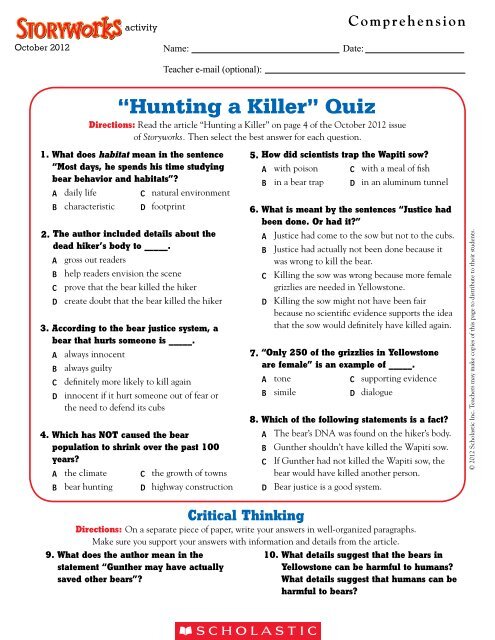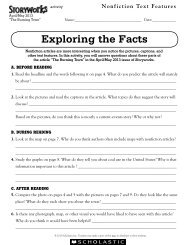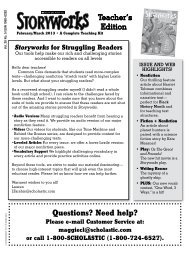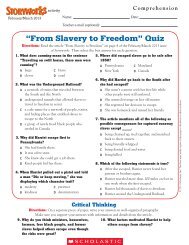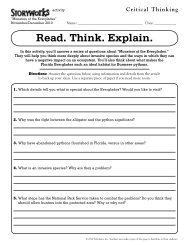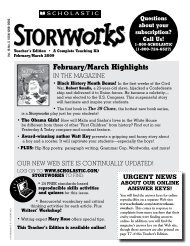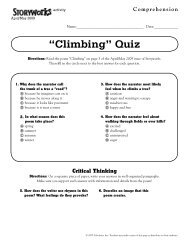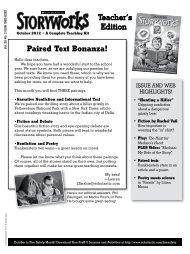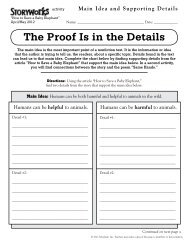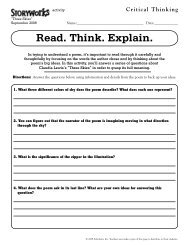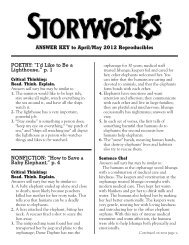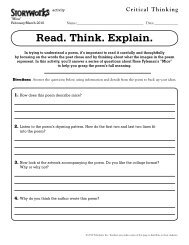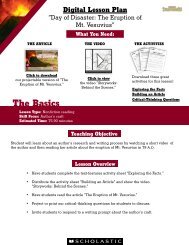?Hunting a Killer? Quiz - Storyworks Magazine - Scholastic
?Hunting a Killer? Quiz - Storyworks Magazine - Scholastic
?Hunting a Killer? Quiz - Storyworks Magazine - Scholastic
Create successful ePaper yourself
Turn your PDF publications into a flip-book with our unique Google optimized e-Paper software.
October 2012<br />
activity<br />
“<strong>Hunting</strong> a <strong>Killer</strong>” <strong>Quiz</strong><br />
Directions: Read the article “<strong>Hunting</strong> a <strong>Killer</strong>” on page 4 of the October 2012 issue<br />
of <strong>Storyworks</strong>. Then select the best answer for each question.<br />
Critical Thinking<br />
Directions: On a separate piece of paper, write your answers in well-organized paragraphs.<br />
Make sure you support your answers with information and details from the article.<br />
9. What does the author mean in the<br />
statement “Gunther may have actually<br />
saved other bears”?<br />
Name: Date:<br />
Teacher e-mail (optional):<br />
1. What does habitat mean in the sentence<br />
“Most days, he spends his time studying<br />
bear behavior and habitats”?<br />
A daily life C natural environment<br />
B characteristic D footprint<br />
2. The author included details about the<br />
dead hiker’s body to _____.<br />
A gross out readers<br />
B help readers envision the scene<br />
C prove that the bear killed the hiker<br />
D create doubt that the bear killed the hiker<br />
3. According to the bear justice system, a<br />
bear that hurts someone is _____.<br />
A always innocent<br />
B always guilty<br />
C definitely more likely to kill again<br />
D innocent if it hurt someone out of fear or<br />
the need to defend its cubs<br />
4. Which has NOT caused the bear<br />
population to shrink over the past 100<br />
years?<br />
A the climate C the growth of towns<br />
B bear hunting D highway construction<br />
Comprehension<br />
5. How did scientists trap the Wapiti sow?<br />
A with poison C with a meal of fish<br />
B in a bear trap D in an aluminum tunnel<br />
6. What is meant by the sentences “Justice had<br />
been done. Or had it?”<br />
A Justice had come to the sow but not to the cubs.<br />
B Justice had actually not been done because it<br />
was wrong to kill the bear.<br />
C Killing the sow was wrong because more female<br />
grizzlies are needed in Yellowstone.<br />
D Killing the sow might not have been fair<br />
because no scientific evidence supports the idea<br />
that the sow would definitely have killed again.<br />
7. “Only 250 of the grizzlies in Yellowstone<br />
are female” is an example of _____.<br />
A tone C supporting evidence<br />
B simile D dialogue<br />
8. Which of the following statements is a fact?<br />
A The bear’s DNA was found on the hiker’s body.<br />
B Gunther shouldn’t have killed the Wapiti sow.<br />
C If Gunther had not killed the Wapiti sow, the<br />
bear would have killed another person.<br />
D Bear justice is a good system.<br />
10. What details suggest that the bears in<br />
Yellowstone can be harmful to humans?<br />
What details suggest that humans can be<br />
harmful to bears?<br />
© 2012 <strong>Scholastic</strong> Inc. Teachers may make copies of this page to distribute to their students.
October 2012<br />
activity<br />
“Good Enough” <strong>Quiz</strong><br />
Directions: Read the story “Good Enough” on page 10 of the October 2012 issue of <strong>Storyworks</strong>.<br />
Then select the best answer for each question.<br />
1. Why does Dori want an Orion shirt?<br />
A She loves the design of the shirts.<br />
B She wants to wear the same clothes as<br />
everybody else.<br />
C Lisa and Carleen make fun of her for not<br />
having an Orion shirt.<br />
D She wants to impress Nate.<br />
2. Why does Dori cry when she receives an<br />
imitation Orion shirt?<br />
A She wishes she had a real Orion shirt.<br />
B She hates the color.<br />
C She is ashamed of her own interest in<br />
clothes.<br />
D She is unhappy that her mom spent so little<br />
money on her.<br />
3. You can infer that Dori constantly chews<br />
on her lips because she feels _____.<br />
A angry C content<br />
B fortunate D anxious<br />
4. What does sympathetically mean in the<br />
sentence “She smiled sympathetically,<br />
which is what made me feel bad”?<br />
A coldly C obviously<br />
B kindly D meanly<br />
9. What clues suggest that Lisa and Carleen<br />
value clothes?<br />
Name: Date:<br />
Teacher e-mail (optional):<br />
Comprehension<br />
5. What does Dori do right after modeling<br />
the fake Orion shirt for her family?<br />
A drinks iced tea with her mom<br />
B calls her friends to tell them what she got<br />
C goes to her room and puts on her pajamas<br />
D does her math homework<br />
6. Which of the following best describes<br />
Dori’s mother?<br />
A unintelligent C caring<br />
B aggressive D selfish<br />
7. What is the resolution of the story, or the<br />
solution to the conflict?<br />
A Dori wears her imitation Orion shirt to<br />
school.<br />
B Carleen taunts Dori for wearing a fake shirt.<br />
C Dori cries because she is ashamed to wear a<br />
fake shirt.<br />
D Dori realizes that her mother’s love is more<br />
important than any piece of clothing.<br />
8. At the end of the story, you can tell that<br />
Dori feels _____.<br />
A proud C excited<br />
B disappointed D ashamed<br />
Critical Thinking<br />
Directions: On a separate piece of paper, write your answers in well-organized paragraphs.<br />
Make sure you support your answers with information and details from the story.<br />
10. Why do you think the story is titled “Good<br />
Enough”?<br />
© 2012 <strong>Scholastic</strong> Inc. Teachers may make copies of this page to distribute to their students.
October 2012<br />
activity<br />
The Hunt for Medusa’s Head <strong>Quiz</strong><br />
Directions: Read the play The Hunt for Medusa’s Head on page 18 of the October 2012 issue<br />
of <strong>Storyworks</strong>. Then select the best answer for each question.<br />
Critical Thinking<br />
Directions: On a separate piece of paper, write your answers in well-organized paragraphs.<br />
Make sure you support your answers with information and details from the play.<br />
9. What clues in the play tell you that the<br />
King is an evil man?<br />
Name: Date:<br />
Teacher e-mail (optional):<br />
1. Why does the King send Perseus to<br />
capture Medusa’s head?<br />
A The King wants to get rid of Perseus<br />
because he thinks Perseus is annoying.<br />
B The King has always wanted Medusa’s<br />
head.<br />
C The King wants to marry Perseus’ mother,<br />
so he needs to get rid of protective Perseus.<br />
D Perseus was the perfect man for the job<br />
because he was the bravest hero in Greece.<br />
2. How does the King get Perseus to go on<br />
such a dangerous adventure?<br />
A He calls Perseus poor and lazy.<br />
B He commands Perseus to go.<br />
C He asks politely.<br />
D He tries to marry Perseus’ mother.<br />
3. What did Athena give Perseus?<br />
A a metal shield C a magic sickle<br />
B a silver sword D the Cap of Darkness<br />
4. What is a synonym for diabolical in the<br />
line “She is a diabolical creature”?<br />
A sneaky C smart<br />
B wicked D determined<br />
Comprehension<br />
5. Why do the Gray Sisters reveal how to<br />
find Medusa?<br />
A The sisters hate Medusa and want Perseus<br />
to destroy her.<br />
B The sisters are afraid of Perseus.<br />
C Perseus tricks them into telling.<br />
D Perseus threatens to throw their eye into<br />
the sea.<br />
6. Which character trait allowed Perseus to<br />
walk into Medusa’s cave?<br />
A jealousy C overconfidence<br />
B courage D meekness<br />
7. When the Gorgon sisters realize that<br />
Medusa is dead, they feel ______.<br />
A frightened C furious<br />
B joyful D humiliated<br />
8. At the end of the play, Perseus ______.<br />
A lets the King hold Medusa’s head.<br />
B kills Medusa’s sisters.<br />
C runs away with his mother.<br />
D becomes known as a great hero.<br />
10. Why does Perseus turn the King and his<br />
advisers to stone?<br />
© 2012 <strong>Scholastic</strong> Inc. Teachers may make copies of this page to distribute to their students.
October 2012<br />
activity<br />
Frankenstein Paired-Texts <strong>Quiz</strong><br />
Directions: Read the paired texts about Frankenstein starting on page 26 of the October 2012 issue of<br />
<strong>Storyworks</strong>. Then select the best answer for each question.<br />
1. In Mary Shelley’s book, who is named<br />
Frankenstein?<br />
A the collage artist<br />
B the monster created from human parts<br />
C a flesh-eating dog<br />
D the scientist who created the monster<br />
Critical Thinking<br />
Directions: On a separate piece of paper, write your answers in well-organized paragraphs.<br />
Make sure you support your answers with information and details from the articles.<br />
9. How are the two monsters like one<br />
another? In what ways do they differ?<br />
Name: Date:<br />
Teacher e-mail (optional):<br />
2. In addition to fear, what can you infer<br />
Victor Frankenstein felt upon first seeing his<br />
creation?<br />
A amusement C disappointment<br />
B boredom D pride<br />
3. According to the article, some of the earliest<br />
monsters can be found in . . .<br />
A Greek and Roman myths.<br />
B songs from ancient Mexico.<br />
C cave paintings in France.<br />
D tall tales from the Old West.<br />
4. What is the meaning of Frankensteinesque<br />
in Calef Brown’s poem?<br />
A possessing qualities similar to those of Shelley’s<br />
monster<br />
B afraid of the monster from Frankenstein<br />
C like the scientist Victor Frankenstein<br />
D eager to have breakfast with fans<br />
Comprehension<br />
5. What is the likely reason that test tubes are<br />
used as illustrations for the article?<br />
A Franken Berry cereal is manufactured in test<br />
tubes.<br />
B The liquids’ colors brighten up the magazine.<br />
C Their shapes fit well on the page.<br />
D They represent scientists and experiments.<br />
6. What is a synonym for gruff in the poem’s<br />
line “My gruff talk”?<br />
A elegant C friendly<br />
B rude D fast<br />
7. What is one way the monster pictures<br />
accompanying the article and poem differ<br />
from the description in Mary Shelley’s book?<br />
A The book describes the monster as wearing<br />
eyeglasses.<br />
B Shelley’s monster has yellow skin.<br />
C Both of the above answers are correct.<br />
D None of the above answers is correct.<br />
8. Cyclopes, from mythology, are . . .<br />
A three-headed, flesh-eating dogs.<br />
B yellow-skinned, murderous monsters.<br />
C one-eyed, man-eating giants.<br />
D charming but lonely misfits.<br />
10. Why does the writer end the article<br />
with the phrase “Now if they would just<br />
invite him to breakfast”?<br />
© 2012 <strong>Scholastic</strong> Inc. Teachers may make copies of this page to distribute to their students.
October 2012<br />
activity<br />
1. Why does the poet repeat the word older?<br />
A because there are no synonyms for older<br />
B to emphasize the great age of the fossils<br />
C to show that fossils are hard to find<br />
D because the poet is fond of old items<br />
2. The poem compares fossils to which of the<br />
following?<br />
A books<br />
B stories<br />
C ice walls<br />
D mammoths<br />
“Fossils” <strong>Quiz</strong><br />
Directions: Read the poem “Fossils” on page 32 of the October 2012 issue<br />
of <strong>Storyworks</strong>. Then select the best answer for each question.<br />
5. How do the stories told by fossils differ<br />
from regular stories?<br />
Name: Date:<br />
Teacher e-mail (optional):<br />
Comprehension<br />
3. In the poem, what does scrolls mean?<br />
A moves down a page<br />
B ornamental designs<br />
C ancient documents<br />
D walks in a leisurely fashion<br />
4. Where are the fossil stories located?<br />
A in forests turned to stone<br />
B in ice walls<br />
C in dinosaur bones<br />
D all of the above<br />
Critical Thinking<br />
Directions: On a separate piece of paper, write your answers in well-organized paragraphs.<br />
Make sure you support your answers with information and details from the poem.<br />
6. What might be the stories of the<br />
illustrations accompanying the poem?<br />
Choose one of the pictures and write the<br />
first few sentences of its story, beginning<br />
with “Once upon a time.”<br />
© 2012 <strong>Scholastic</strong> Inc. Teachers may make copies of this page to distribute to their students.


